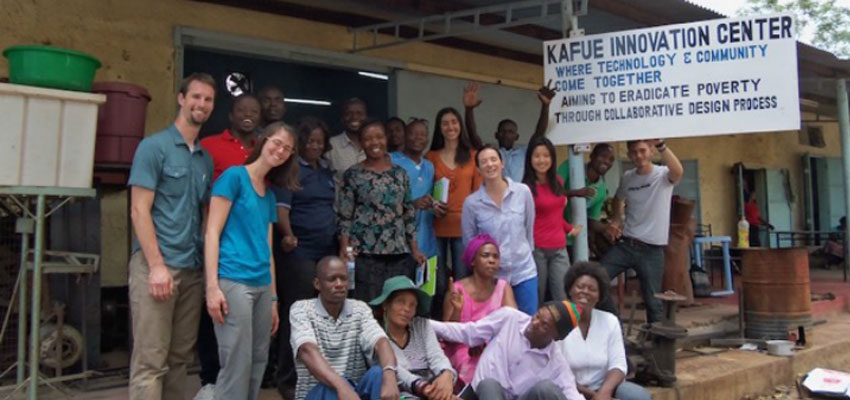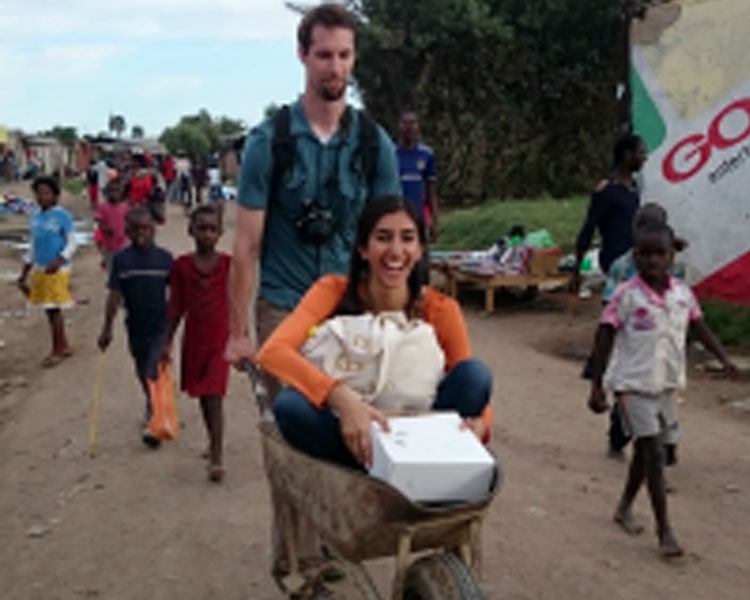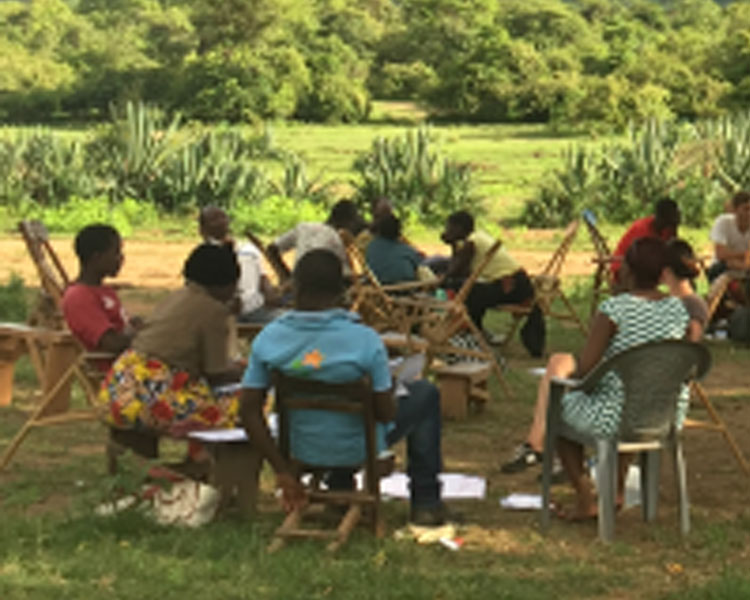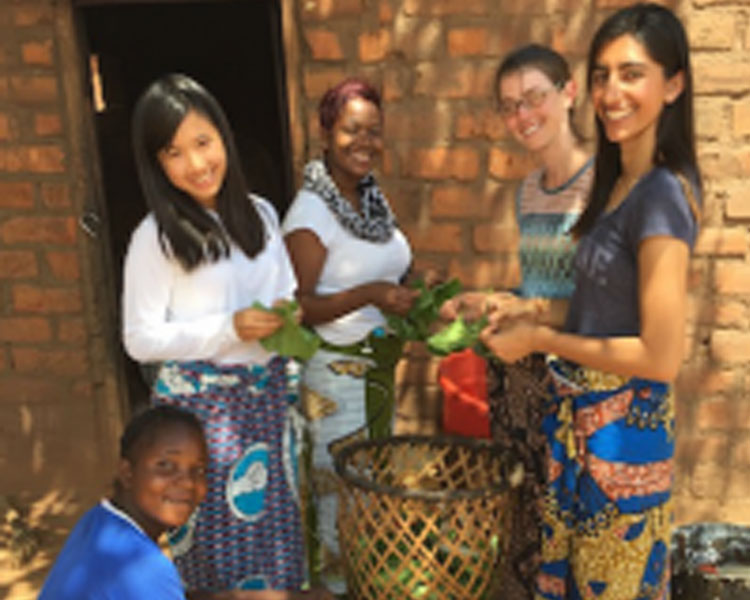
Just a few days into the new year of 2016, I had the amazing opportunity to spend three weeks in Zambia doing fieldwork as part of the D-Lab: Development class, along with fellow classmates Sam and Tiffany, and our trip leaders D-Lab instructor Eric Reynolds and Natalie Brubaker. We worked with the IDIN Kafue Innovation Center, the Zambian government’s National Technology Business Centre (NTBC), and Zasaka, a social enterprise that was incubated by D-Lab’s Scale-Ups program. In the last week of the trip, we also met up with Mine and Paula, who were working on an evaluation framework for Zasaka.
Our work was centered around three projects for which we had been preparing throughout the fall semester:
- leading a customer discovery workshop for local makers and entrepreneurs at the IDIN Kafue Innovation Center
- working with Robert Shimaingo to improve the design of his hydroelectric turbine
- leading a co-design workshop with Zasaka for the farmers of Pwata Village
For me, the completely immersive experience of living, working, and travelling with my teammates and our partners is what made the trip incredible. I gained so much insight into the culture and a more meaningful understanding of the issues we explored in class by experiencing the way of life and challenges our partners’ face firsthand, as well as by working through the customer discovery and co-design processes together.
Furthermore, it was inspiring to see the local solutions our partners have designed within their cultural context and the determination with which they carry them out to overcome their resource constraints. I really enjoyed getting to know everyone and seeing their idiosyncrasies come through by sharing in the mundane together. I know the trip would not have been the adventurous learning experience that it was had it not been for the awesome people on our team and our warm, welcoming, lively friends in Zambia.
Customer Discovery Workshop @ Kafue Innovation Center
After being picked up at the airport by Lulu of NTBC, our invaluable facilitator throughout the trip, we drove from Lusaka to the Kafue Innovation Center to meet our host families with whom we would also be working for the week. After a night of rest with our families in Zambia Compound, we got straight to work the next day, finishing planning the customer discovery workshop and beginning work on the gearbox of Robert’s hydroelectric turbine. Just one of the many complex machines Robert Shimaingo has built, the turbine is intended to power a freezer so that fishermen’s catch can keep long enough to be transported and sold in local markets. Robert hopes that one day the turbine can even electrify the fishing village near which it is submerged.
Sixteen innovators from all around Zambia attended the workshop which was held from Wednesday through Saturday. Each day we focused on a different step of the customer discovery process, which helps entrepreneurs achieve product-market fit by exploring all potential customers, learning more about them through interviews (i.e. their needs and desires, how they make purchasing decisions, etc.), picking a target customer, concretely defining how their product offers value, and then testing how much the customer values the product.
The participants were placed into 4 teams, each of which worked on one of four example products, applying the concepts and tools covered in instruction through field work, discussion, and team presentations. Through the lens of the innovators products, we learned more about some of the issues that arise in daily life for many Zambians. For example, as a solution to the risk of getting burned that many women face when placing pots directly on charcoals or balancing them between the rocks of a three-stone fire to cook, Lesley designed an adjustable pot holder. Another participant created Dissolupit, a chemical powder treatment for pit latrines that when poured into the pit, compacts the accumulated waste and eliminates odors, thereby extending the lifespan of the latrine and delaying the need to dig another pit.
The workshop was a great collaborative process and learning experience for everyone involved- us, the Zambian innovators, and even Kafue community members. We celebrated its successful completion and my 21st birthday with a big cookout at Stephen’s house. As much as we loved all the n’shima we were eating, the staple food made by boiling ground maize and water, we decided to give our hosts a taste of stir-fry!
Robert’s Hydroelectric Turbine Gearbox Installation on the Kafue River
Outside of the workshop, preparation of the gearboxes for installation on the turbine was finished! At the start of the second week, we travelled to Mazabuka where we would stay while working on the turbine. After a bumpy, two-hour van ride from Mazabuka, we arrived at a small, secluded fishing village that became an island when the river flooded. Robert Shimaingo's turbine was stationed right off the banks of the river where the village was situated, and many hands helped carry the near 400lb gearbox onto a boat to bring it there. It only took a few hours in the blistering sun to get the turbine up and running with the improved gearbox. Part of the team returned the following day to make final checks and ensure everything was running smoothly.
Then we travelled to Lusaka before taking an eight hour bus ride to Chipata, our base for the next week!
Co-Design Workshop with Zasaka in Pwata Village
Upon arriving in Chipata, we were greeted by pouring rain and a cheery Sunday Silungwe, co-founder of Zasaka! We spent a relaxing few days in the home/office of Zasaka preparing for the Co-Design Workshop we were to lead in the farming village of Pwata, in the wonderful company of Carl, also co-founder of Zasaka, James, Simba (the dog), and Zuba (the cat).
We would be joined for the five-day workshop by many of the curriculum discovery participants, and we all stayed in the homes of several families in the village. In the mornings, we would help our host families with work on the farm and chores around the house. Then, after lunch with all the workshop participants, we led the co-design workshop. The design challenge was to improve farmers’ access to high capital equipment, such as ploughs, oxen, sprayers, and herbicides. Each of the five teams chose to focus on a specific type of equipment. In order to identify the causes underlying poor access to equipment and select one problem framing for which to generate solutions, each team drew upon their collective knowledge and conducted interviews. Then, each team brainstormed potential solutions to their problem framing and prototyped the most promising one. The workshop concluded with final team presentations, during which all participants received feedback on how they can improve their prototypes and take their solutions forward after the workshop.
I learned so much about the inputs, equipment, and processes involved with farming, the market for crops, as well as how farmers decide when and who to sell to, and how this affects their budgeting. My appreciation for the business, science, and physical practice of farming only grew during our time in Pwata.
We also had a truly rare and incredible cultural experience, albeit for a tragic reason. The son-in-law of Tiffany and my host parents passed early the morning after we arrived. We were a part of the mourning, grave digging, and funeral, all of which took place over the course of those three days. On the day of the funeral, no one went out to the farms . There were at least 1,000 people in attendance, from Pwata as well as the 10 surrounding villages.
Cruising the Kafue River, Dancing, and Leopard Spotting
Amidst working on our projects throughout the trip, we found ways to enjoy ourselves, too. The day following the end of the customer discovery workshop, we took our host families from the Innovation Center on a boat cruise on the Kafue River. We all got so excited when we sighted the eyes and snouts of nearly 8 hippopotamuses above the water!
On our second night at the Zasaka house, someone started playing music, which spontaneously transformed the living room into an international dance circle, with Paula teaching the salsa, Mine teaching belly dancing, me teaching bhangra, John and Sunday teaching the popular Zambian dance style, and Natalie teaching various American line dances. No one was spared the embarrassment of sharing their moves. It was a night no one will forget, because, well, there are videos …
After finishing the co-design workshop and returning from Pwata, we made a weekend trip to South Luangwa National Park to go on a safari! We were a lucky bunch and saw every animal whose sighting is coveted, despite it being the off-season, including zebras, lions, giraffes, hyenas, elephants, antelope, and leopards, just to name a few!







